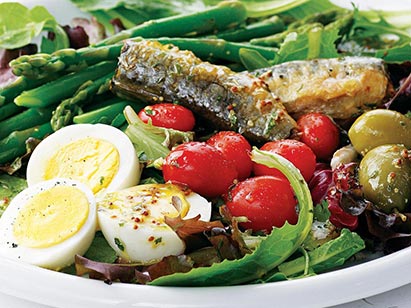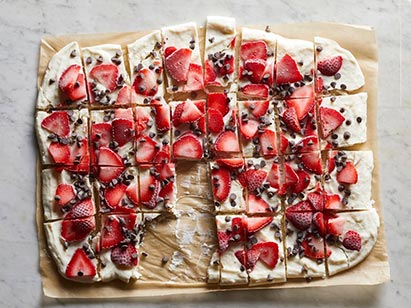How to Build Your Kidney Disease Meal Plan
Five Tips for Creating a Healthy and Delicious Kidney Disease Meal Plan
1. Know your kidney health needs
Every person has their own dietary needs, and depending on your stage of kidney disease and how it’s being treated, these requirements may change. For example, if you’re on dialysis, you may need to pay extra attention to your fluid intake and pump up the protein. If you have other health conditions like diabetes or heart disease, you’ll need to factor those needs into your diet as well. If you’re working with a dietitian, they can help you create a custom kidney disease meal plan that supports your whole health. If you’re not seeing a dietitian, talk to your doctor for meal-planning advice.
2. Monitor your minerals
- Shake off the salt. Healthy kidneys balance the sodium and fluid levels in your body, but with CKD, you’ll need to help support this process by minimizing your sodium intake.
Suggested recipe: Lemon Orzo Spring Salad
- Cut down on phosphorus. With CKD, phosphorus may build up and become harmful to your bones or heart health. It occurs naturally in many foods and is sometimes added as a preservative, so check the nutrition label and watch out for any words that start with “phos-.”
Suggested recipe: Classic Lasagna
- Eat low-potassium foods. Potassium is important for your health, but with CKD, your kidneys have trouble keeping this nutrient in check. Excess potassium can build up and cause issues with your heart and nerves.
Suggested recipe: Chilled Veggie and Shrimp Noodle Salad
- Be picky about proteins. In moderation, protein keeps muscles strong and healthy. To minimize waste buildup, choose high-quality proteins like fish or chicken — or try plant-based proteins to put less stress on your kidneys. Eating beans, tofu, nuts, and other plant-based proteins has been shown to help slow the progression of kidney disease and keep people with CKD healthier longer.1,2
Suggested recipe: Spicy Tofu Scrambler
3. Learn how to read nutrition labels
To stay kidney-friendly, aim for the following % DV with each serving:
- Dietary fiber — more than 10% DV
- Saturated fat — less than 10% DV
- Trans fat — none
- Sodium — less than 10% DV
- Added sugars — less than 10% DV
And remember, people living with kidney disease should avoid foods that say “phos-” on the label.

Instructional nutritional facts label shows people living with chronic kidney disease what to look for when shopping. The best options should have no trans fats, less than 10% of the daily value of saturated fats, sodium, and added sugars, as well as more than 10% of the daily value of dietary fiber.
4. Portion your plate
Hint: Remember that if you want to eat two serving sizes, all the nutrients and % DV will also double.
Here are some handy tips for estimating portion sizes:
- 3–5 ounces of protein is about the size of the palm of your hand
- ½ cup of fruits and veggies is the amount that could fit within your cupped hand
- 1 cup of breads and grains is about the size of your fist

A divided plate ready to be filled with suggested serving sizes: 3-5 ounces protein (about the size of your palm), half cup fruits and veggies (size of cupped hand), 1 cup breads and grains (size of a closed fist), and fluid serving of 4 ounces.
5. Enjoy kidney-friendly meals all day long

Breakfast idea: Egg & Sausage Casserole

Lunch idea: Spring Salad with Tarragon Vinaigrette

Dinner idea: Easier Than Your Mama’s Meatloaf

Dessert idea: Strawberry & Chocolate Frozen Yogurt Bark
Strike a Balance When Making Your Kidney Disease Meal Plan
References
1 1. Chen X, Wei G, Jalili T, Metos J, Giri A, Cho ME, Boucher R, Greene T, Beddhu S. The Associations of Plant Protein Intake With All-Cause Mortality in CKD. Am J Kidney Dis. 2016 Mar;67(3):423-30. doi: 10.1053/j.ajkd.2015.10.018. Epub 2015 Dec 10. PMID: 26687923; PMCID: PMC4769135.
2 2. Alvirdizadeh S, Yuzbashian E, Mirmiran P, Eghtesadi S, Azizi F. A prospective study on total protein, plant protein and animal protein in relation to the risk of incident chronic kidney disease. BMC Nephrol. 2020 Nov 17;21(1):489. doi: 10.1186/s12882-020-02079-y. PMID: 33203389; PMCID: PMC7672990.
Suggested topics

Grocery Shopping Made Simple with a Kidney-Friendly Food List
Which Fish Are Best to Eat with Kidney Disease?
Medications to Avoid or Adjust If You Have Chronic Kidney Disease
When your kidneys don’t function the way they should, prescription and over-the-counter medications can build up in your blood and may cause additional damage to your kidneys or other parts of your body...
